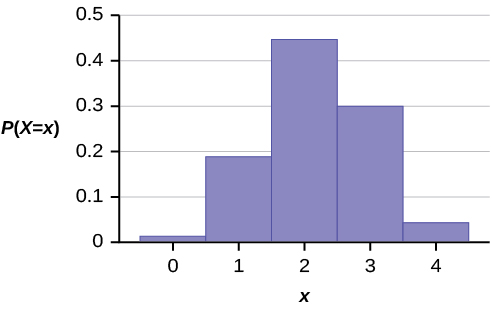Chapter 4: Discrete Random Variables
4.5 Hypergeometric Distribution
Learning Objectives
By the end of this section, you should be able to:
- Identify the components of a hypergeometric experiment
- Use the formulas for a hypergeometric random variable to compute the mean
There are five characteristics of a hypergeometric experiment.
- You take samples from two groups.
- You are concerned with a group of interest, called the first group.
- You sample without replacement from the combined groups. For example, you want to choose a softball team from a combined group of 11 men and 13 women. The team consists of ten players.
- Each pick is not independent, since sampling is without replacement. In the softball example, the probability of picking a woman first is [latex]\frac{13}{24}[/latex]. The probability of picking a man second is [latex]\frac{11}{23}[/latex] if a woman was picked first. It is [latex]\frac{10}{23}[/latex] if a man was picked first. The probability of the second pick depends on what happened in the first pick.
- You are not dealing with Bernoulli Trials.
The outcomes of a hypergeometric experiment fit a hypergeometric probability distribution. The random variable X = the number of items from the group of interest.
Example
A candy dish contains 100 jelly beans and 80 gumdrops. Fifty candies are picked at random. What is the probability that 35 of the 50 are gumdrops?
This experiment is hypergeometric: the two groups are jelly beans and gumdrops. Since the probability question asks for the probability of picking gumdrops, the group of interest (first group) is gumdrops and size 80. The size of the second group, jelly beans, is 100. The size of the sample is 50 (jelly beans or gumdrops).
Let X = the number of gumdrops in the sample of 50. X takes on the values x = 0, 1, 2, …, 50. What is the probability statement written mathematically?
Solution
P(x = 35)
Your Turn!
A bag contains letter tiles. Forty-four of the tiles are vowels, and 56 are consonants. Seven tiles are picked at random. You want to know the probability that four of the seven tiles are vowels. What is the group of interest, the size of the group of interest, and the size of the sample?
Your Turn!
You are president of an on-campus special events organization. You need a committee of seven students to plan a special birthday party for the president of the college. Your organization consists of 18 women and 15 men. If the members of the committee are randomly selected, what is the probability that your committee has more than four men?
a. Are you choosing with or without replacement?
Solution
a. without
b. What is the group of interest?
Solution
b. the men
c. How many are in the group of interest?
Solution
c. 15 men
d. How many are in the other group?
Solution
d. 18 women
e. Let X = _________ on the committee. What values does X take on?
Solution
e. Let X = the number of men on the committee. x = 0, 1, 2, …, 7.
f. The probability question is P(_______).
Solution
f. P(x > 4)
Notation and Mean for the Hypergeometric
The notation for the Geometric Probability Distribution function is [latex]H[/latex], and we denote “X is a random variable with a hypergeometric probability distribution as [latex]X \sim H (r, b, n).[\latex]
The parameters are r, b, and n; r = the size of the group of interest (first group), b = the size of the second group, n = the size of the chosen sample. Most of the formulas for the Hypergeometric distribution are beyond the scope of this book; the exception is the mean.
[latex]\mu =\frac{nr}{r+b}[/latex]
Note
Currently, the TI-83/84 calculators do not have a built-in hypergeometric distribution button. You can calculate probabilities in Excel using HYPGEO.DIST(x, n, r, r+b, True/False), where False computes [latex]P(X=x)[/latex], and True computes [latex]P(X \leq x)[/latex].
Your Turn!
A school site committee is to be chosen randomly from five men and six women. If the committee consists of four members chosen randomly, what is the probability that two of them are women? How many women do you expect to be on the committee?
Let X = the number of women on the committee of four. The women are the group of interest (first group). The random variable X takes on the values 0, 1, 2, 3, 4, where r = 6, b = 5, and n = 4, and X ~ H(6, 5, 4).
The graph of X ~ H(6, 5, 4) is below.

The y-axis contains the probability of X, where X = the number of men on the committee.
Your Turn!
An intramural basketball team is to be chosen randomly from 15 upperclassmen and 12 underclassmen. The team has ten slots. You want to know the probability that eight of the players will be upperclassmen. What is the group of interest and the sample? Find the probability using a computer.
a statistical experiment with the following properties:
1. You take samples from two groups.
2. You are concerned with a group of interest, called the first group.
3. You sample without replacement from the combined groups.
4. Each pick is not independent, since sampling is without replacement.
5. You are not dealing with Bernoulli Trials.
a discrete random variable (RV) that is characterized by:
1. A fixed number of trials.
2. The probability of success is not the same from trial to trial.
We sample from two groups of items when we are interested in only one group. X is defined as the number of successes out of the total number of items chosen. Notation: X ~ H(r, b, n), where r = the number of items in the group of interest, b = the number of items in the group not of interest, and n = the number of items chosen.

